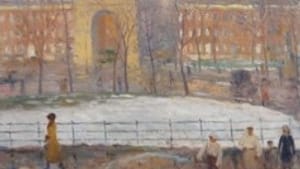Stay in the Loop
BSR publishes on a weekly schedule, with an email newsletter every Wednesday and Thursday morning. There’s no paywall, and subscribing is always free.
Those overlooked Americans at the Barnes
American painters in the Barnes

The stars of The Barnes Collection are European, especially Renoir, Cezanne, Matisse and other Moderns, with a generous supporting cast of credited and anonymous works from earlier centuries and various regions. It's also a global and folk art collection, famous for its quirky ensembles of metalwork, pottery, colonial woodcraft, etc.
Given the buzz around these aspects, it's easy to overlook the fact that the Barnes is also an important collection of American art. The collection tells a compelling story of American art and artists— not only the charming homely tale of native artisans, but also a modern saga, beginning with William Glackens.
Glackens was a former Central High classmate of Barnes who had lived and studied in Paris and was established as a painter and illustrator in New York. In 1912, when Barnes had made his fortune from Argyrol, he sent Glackens to Europe to make his first purchases.
Between Glackens's choices and the subsequent purchases made by Barnes himself, the collection now holds astonishing numbers of European masters from the period: 181 Renoirs, 67 works by Cézanne, 59 by Matisse.
Barnes at the Armory?
Barnes's buying trips to Europe are well documented, but given his predilection for the new and controversial, he surely also traveled to New York in 1913 for the notorious Armory Show, the event that introduced Americans to Modern Art. Barnes would have loved the confirmation of his bold tastes in art and certainly would have relished the vitriolic reviews and the uproar over the show's so-called "barbaric art."
The Modernism on view at the Armory Show wasn't exclusively foreign, so Barnes would have seen the revolutionaries of American Art hanging side by side with the European avant-garde. Glackens had work hanging in the show, as did John Sloan, George Luks, Maurice Prendergast and others loosely grouped as "The Ashcan School"— painters rebelling against conservative American tastes with realistic genre scenes of ordinary life in New York's gritty streets.
Even though many of the American works that Barnes chose to include in his collection are relatively minor or at least mild (with an abundance of works on paper), it's a significant holding nevertheless. Glackens dominates it by quantity, with 71 paintings and drawings, including genre scenes such as Street Cleaners, Washington Square (1910) and The Little Pier (1914.) Glackens, as much a Renoir enthusiast as Barnes, was sometimes called "The American Renoir," especially after he began distancing himself from the darker tendencies of the Ashcan School.
Barnes's softer side
Maurice Prendergast, a friend of Glackens who spent most of his life in New England, caught Barnes's eye for his colorful outdoor scenes of beach and sea outings; both he and his brother Charles, a crafter of frames and paintings on wood, are represented in the collection.
Charles Demuth, a Pennsylvania native from Lancaster, though never associated with the Ashcan School, was clearly a Barnes favorite too, particularly for his delicate, lightly drawn watercolors. Demuth, whose friendship with the poet William Carlos Williams inspired his best-known work— the bright graphic painting Figure 5 (at the Museum of Modern Art in New York)— shows us a softer, more intimate side in the Barnes Collection. The Americans in the Barnes tell a strong, interesting, modern story.♦
To read a response, click here.
Given the buzz around these aspects, it's easy to overlook the fact that the Barnes is also an important collection of American art. The collection tells a compelling story of American art and artists— not only the charming homely tale of native artisans, but also a modern saga, beginning with William Glackens.
Glackens was a former Central High classmate of Barnes who had lived and studied in Paris and was established as a painter and illustrator in New York. In 1912, when Barnes had made his fortune from Argyrol, he sent Glackens to Europe to make his first purchases.
Between Glackens's choices and the subsequent purchases made by Barnes himself, the collection now holds astonishing numbers of European masters from the period: 181 Renoirs, 67 works by Cézanne, 59 by Matisse.
Barnes at the Armory?
Barnes's buying trips to Europe are well documented, but given his predilection for the new and controversial, he surely also traveled to New York in 1913 for the notorious Armory Show, the event that introduced Americans to Modern Art. Barnes would have loved the confirmation of his bold tastes in art and certainly would have relished the vitriolic reviews and the uproar over the show's so-called "barbaric art."
The Modernism on view at the Armory Show wasn't exclusively foreign, so Barnes would have seen the revolutionaries of American Art hanging side by side with the European avant-garde. Glackens had work hanging in the show, as did John Sloan, George Luks, Maurice Prendergast and others loosely grouped as "The Ashcan School"— painters rebelling against conservative American tastes with realistic genre scenes of ordinary life in New York's gritty streets.
Even though many of the American works that Barnes chose to include in his collection are relatively minor or at least mild (with an abundance of works on paper), it's a significant holding nevertheless. Glackens dominates it by quantity, with 71 paintings and drawings, including genre scenes such as Street Cleaners, Washington Square (1910) and The Little Pier (1914.) Glackens, as much a Renoir enthusiast as Barnes, was sometimes called "The American Renoir," especially after he began distancing himself from the darker tendencies of the Ashcan School.
Barnes's softer side
Maurice Prendergast, a friend of Glackens who spent most of his life in New England, caught Barnes's eye for his colorful outdoor scenes of beach and sea outings; both he and his brother Charles, a crafter of frames and paintings on wood, are represented in the collection.
Charles Demuth, a Pennsylvania native from Lancaster, though never associated with the Ashcan School, was clearly a Barnes favorite too, particularly for his delicate, lightly drawn watercolors. Demuth, whose friendship with the poet William Carlos Williams inspired his best-known work— the bright graphic painting Figure 5 (at the Museum of Modern Art in New York)— shows us a softer, more intimate side in the Barnes Collection. The Americans in the Barnes tell a strong, interesting, modern story.♦
To read a response, click here.
What, When, Where
Barnes Foundation. 2025 Benjamin Franklin Parkway. (215) 778-7000 or www.barnesfoundation.org.
Sign up for our newsletter
All of the week's new articles, all in one place. Sign up for the free weekly BSR newsletters, and don't miss a conversation.

 Marilyn MacGregor
Marilyn MacGregor